
Human vs AI
AI vs Human Writing: What Makes the Difference in 2025
Author: Michael Perkins
Updated: Oct 13, 2025
min
Table of contents
Can a machine ever write something that truly feels human? That question has followed every classroom and workplace since tools like ChatGPT became mainstream. To find a real answer, we decided to put both sides to the test and compared essays written by five leading AI tools and one human through tone, originality, and emotional weight.
For the AI vs human writing experiment, our expert essay writers crafted the prompt: ‘Write a 300-word persuasive essay on why failure is essential for growth.’
The Prompt & Method
We tested 5 different AI tools and primarily analyzed them through three main criteria:
- How long each took
- How much editing they needed
- Whether they felt ‘generic’ or ‘alive’
We came up with a single prompt and used it for all 5 tools.
Here’s the prompt: ‘Write a 300-word persuasive essay on why failure is essential for growth. Target: high school or college students.’
The reason we designed this prompt is simple: the topic is ideal for demonstrating emotions, arguments, and reflection. A great way to compare AI VS human creativity - especially when judged by professionals like our law essay writers, who understand both structure and nuance.
Here’s what we found out:
- ChatGPT (GPT-4): It took 50 seconds, needed minimal editing, and felt slightly more alive than others.
- Writesonic: It took 30 seconds, needed moderate editing, and felt generic.
- Anyword: It took 1.5 minutes, needed heavy editing, and felt very generic.
- Rytr: It took 1 minute, needed heavy editing, and felt slightly alive.
- Sudowrite: It took 2 minutes, needed minimal editing, and felt very generic.
Raw Results: AI vs Human Text
Read 6 essays. One of them is written by a human, the rest is created by different AI tools.
ChatGPT (GPT-4)
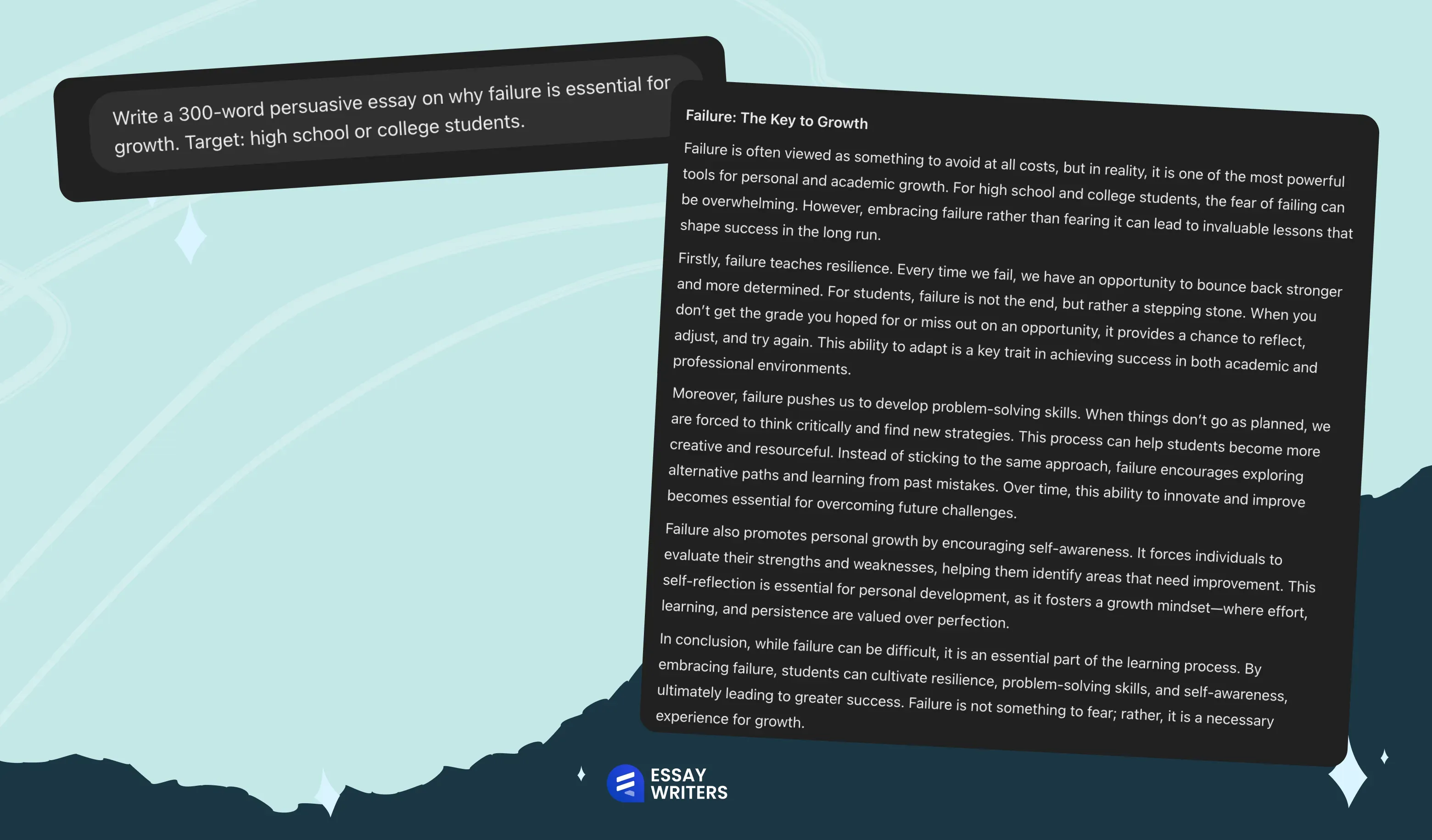
Failure is often viewed as something to avoid at all costs, but in reality, it is one of the most powerful tools for personal and academic growth. For high school and college students, the fear of failing can be overwhelming. However, embracing failure rather than fearing it can lead to invaluable lessons that shape success in the long run.
Firstly, failure teaches resilience. Every time we fail, we have an opportunity to bounce back stronger and more determined. For students, failure is not the end, but rather a stepping stone. When you don’t get the grade you hoped for or miss out on an opportunity, it provides a chance to reflect, adjust, and try again. This ability to adapt is a key trait in achieving success in both academic and professional environments.
Moreover, failure pushes us to develop problem-solving skills. When things don’t go as planned, we are forced to think critically and find new strategies. This process can help students become more creative and resourceful. Instead of sticking to the same approach, failure encourages exploring alternative paths and learning from past mistakes. Over time, this ability to innovate and improve becomes essential for overcoming future challenges.
Failure also promotes personal growth by encouraging self-awareness. It forces individuals to evaluate their strengths and weaknesses, helping them identify areas that need improvement. This self-reflection is essential for personal development, as it fosters a growth mindset—where effort, learning, and persistence are valued over perfection.
In conclusion, while failure can be difficult, it is an essential part of the learning process. By embracing failure, students can cultivate resilience, problem-solving skills, and self-awareness, ultimately leading to greater success. Failure is not something to fear; rather, it is a necessary experience for growth.
Writesonic
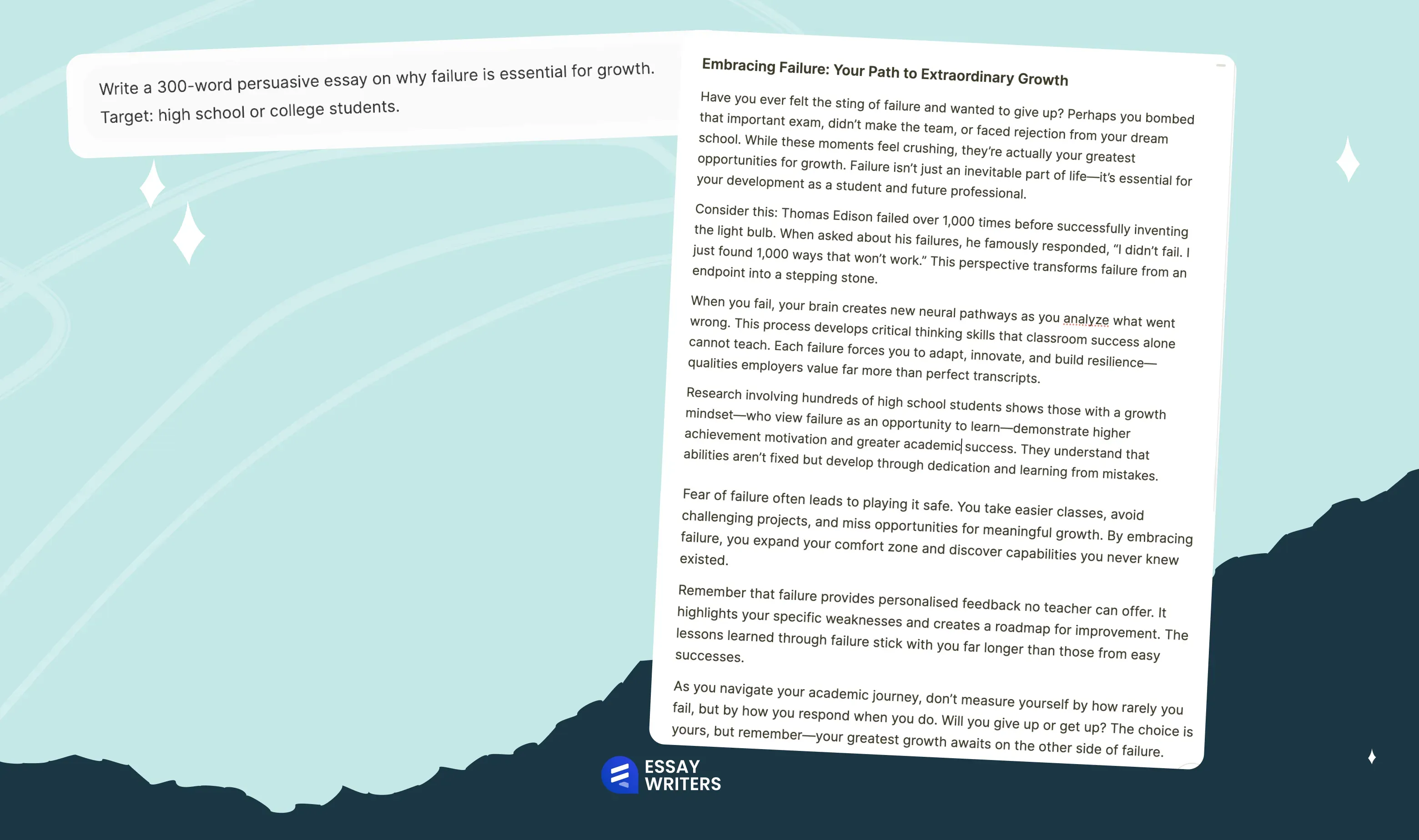
Have you ever felt the sting of failure and wanted to give up? Perhaps you bombed that important exam, didn’t make the team, or faced rejection from your dream school. While these moments feel crushing, they’re actually your greatest opportunities for growth. Failure isn’t just an inevitable part of life—it’s essential for your development as a student and future professional.
Consider this: Thomas Edison failed over 1,000 times before successfully inventing the light bulb. When asked about his failures, he famously responded, “I didn’t fail. I just found 1,000 ways that won’t work.” This perspective transforms failure from an endpoint into a stepping stone.
When you fail, your brain creates new neural pathways as you analyze what went wrong. This process develops critical thinking skills that classroom success alone cannot teach. Each failure forces you to adapt, innovate, and build resilience—qualities employers value far more than perfect transcripts.
Research involving hundreds of high school students shows those with a growth mindset—who view failure as an opportunity to learn—demonstrate higher achievement motivation and greater academic success. They understand that abilities aren’t fixed but develop through dedication and learning from mistakes.
Fear of failure often leads to playing it safe. You take easier classes, avoid challenging projects, and miss opportunities for meaningful growth. By embracing failure, you expand your comfort zone and discover capabilities you never knew existed.
Remember that failure provides personalized feedback no teacher can offer. It highlights your specific weaknesses and creates a roadmap for improvement. The lessons learned through failure stick with you far longer than those from easy successes.
As you navigate your academic journey, don’t measure yourself by how rarely you fail, but by how you respond when you do. Will you give up or get up? The choice is yours, but remember—your greatest growth awaits on the other side of failure.
Anyword
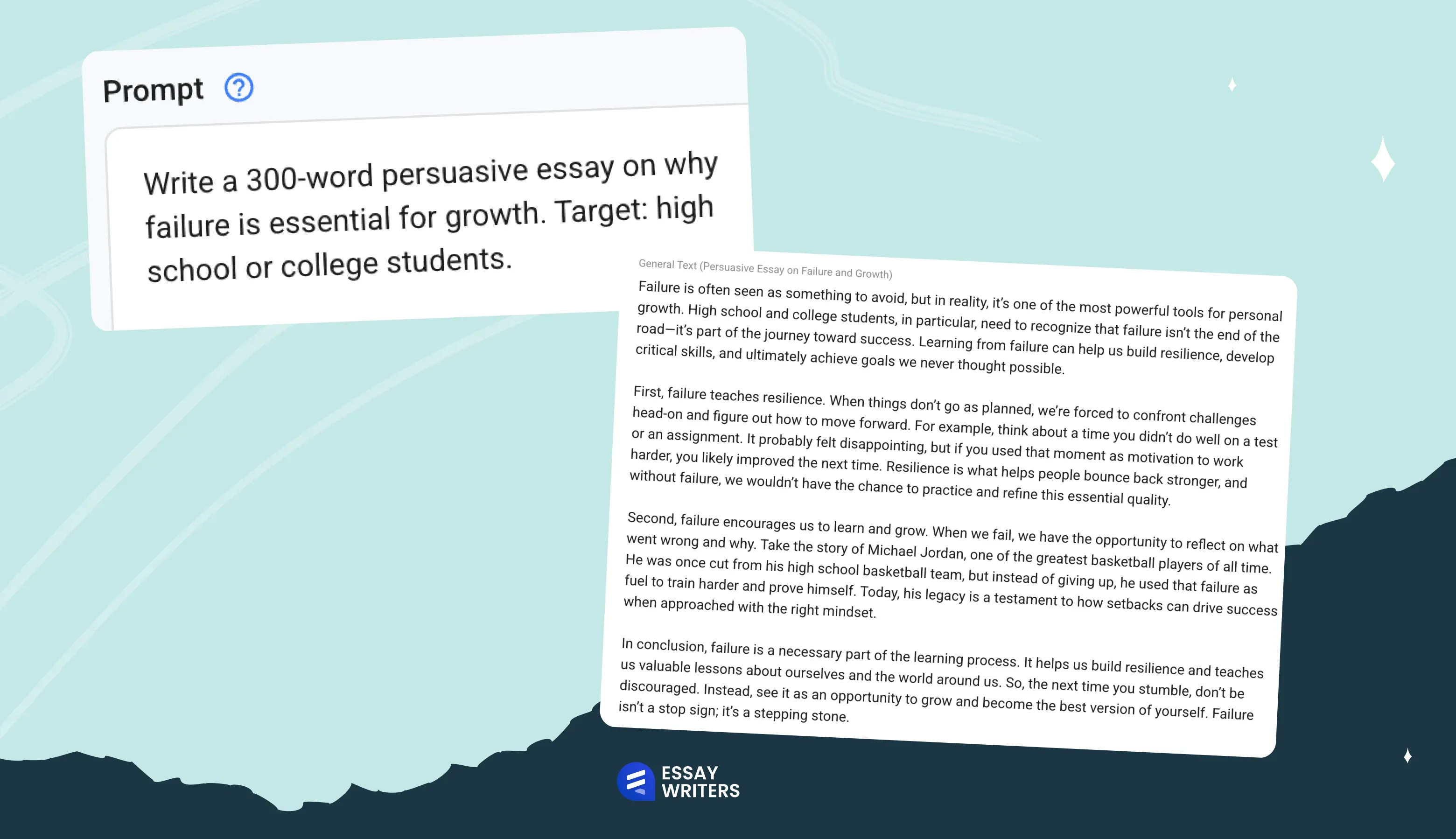
Failure is often seen as something to avoid, but in reality, it’s one of the most powerful tools for personal growth. High school and college students, in particular, need to recognize that failure isn’t the end of the road—it’s part of the journey toward success. Learning from failure can help us build resilience, develop critical skills, and ultimately achieve goals we never thought possible.
First, failure teaches resilience. When things don’t go as planned, we’re forced to confront challenges head-on and figure out how to move forward. For example, think about a time you didn’t do well on a test or an assignment. It probably felt disappointing, but if you used that moment as motivation to work harder, you likely improved the next time. Resilience is what helps people bounce back stronger, and without failure, we wouldn’t have the chance to practice and refine this essential quality.
Second, failure encourages us to learn and grow. When we fail, we have the opportunity to reflect on what went wrong and why. Take the story of Michael Jordan, one of the greatest basketball players of all time. He was once cut from his high school basketball team, but instead of giving up, he used that failure as fuel to train harder and prove himself. Today, his legacy is a testament to how setbacks can drive success when approached with the right mindset.
In conclusion, failure is a necessary part of the learning process. It helps us build resilience and teaches us valuable lessons about ourselves and the world around us. So, the next time you stumble, don’t be discouraged. Instead, see it as an opportunity to grow and become the best version of yourself. Failure isn’t a stop sign; it’s a stepping stone.
Rytr
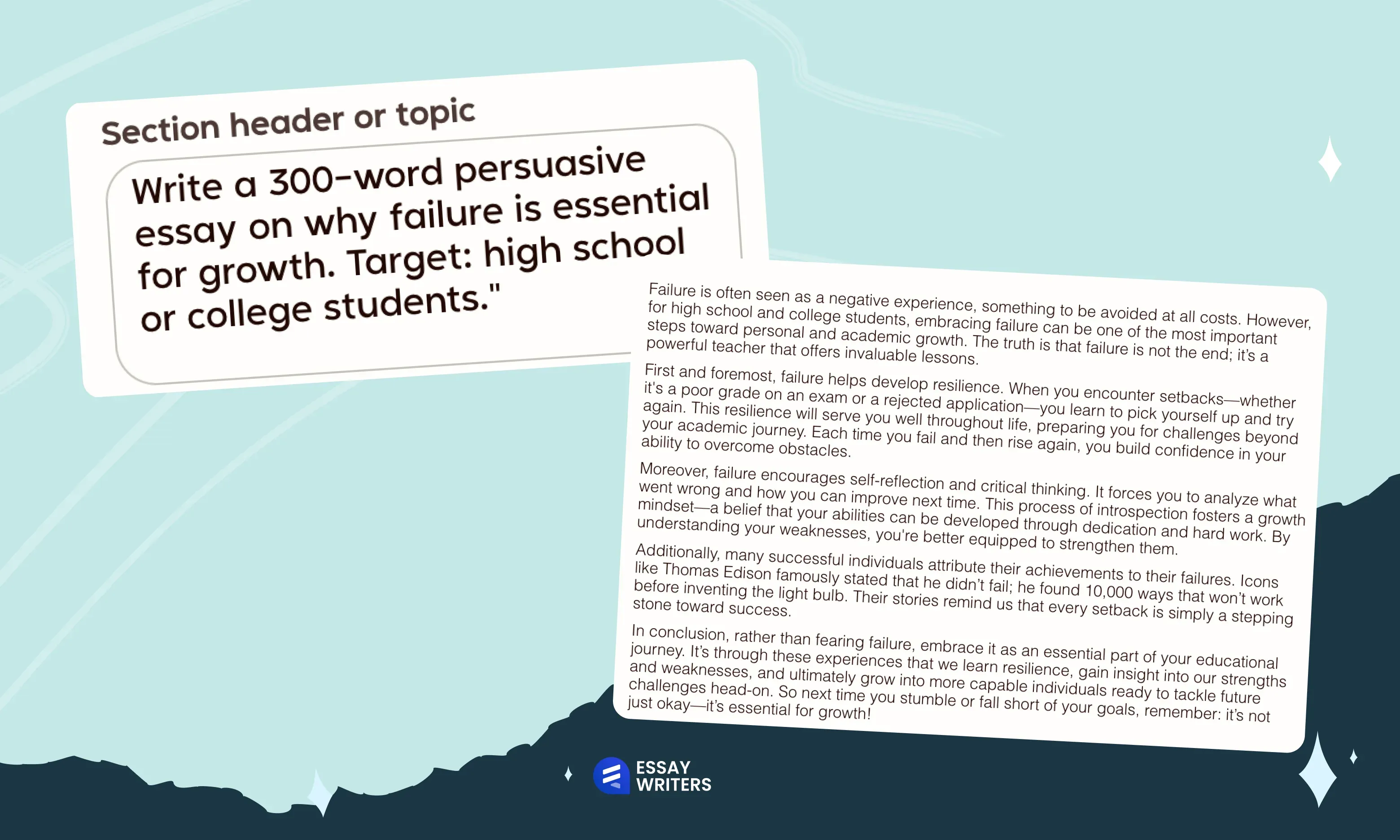
Failure is often seen as a negative experience, something to be avoided at all costs. However, for high school and college students, embracing failure can be one of the most important steps toward personal and academic growth. The truth is that failure is not the end; it’s a powerful teacher that offers invaluable lessons.
First and foremost, failure helps develop resilience. When you encounter setbacks—whether it's a poor grade on an exam or a rejected application—you learn to pick yourself up and try again. This resilience will serve you well throughout life, preparing you for challenges beyond your academic journey. Each time you fail and then rise again, you build confidence in your ability to overcome obstacles.
Moreover, failure encourages self-reflection and critical thinking. It forces you to analyze what went wrong and how you can improve next time. This process of introspection fosters a growth mindset—a belief that your abilities can be developed through dedication and hard work. By understanding your weaknesses, you're better equipped to strengthen them.
Additionally, many successful individuals attribute their achievements to their failures. Icons like Thomas Edison famously stated that he didn’t fail; he found 10,000 ways that won’t work before inventing the light bulb. Their stories remind us that every setback is simply a stepping stone toward success.
In conclusion, rather than fearing failure, embrace it as an essential part of your educational journey. It’s through these experiences that we learn resilience, gain insight into our strengths and weaknesses, and ultimately grow into more capable individuals ready to tackle future challenges head-on. So next time you stumble or fall short of your goals, remember: it’s not just okay — it’s essential for growth!
Sudowrite
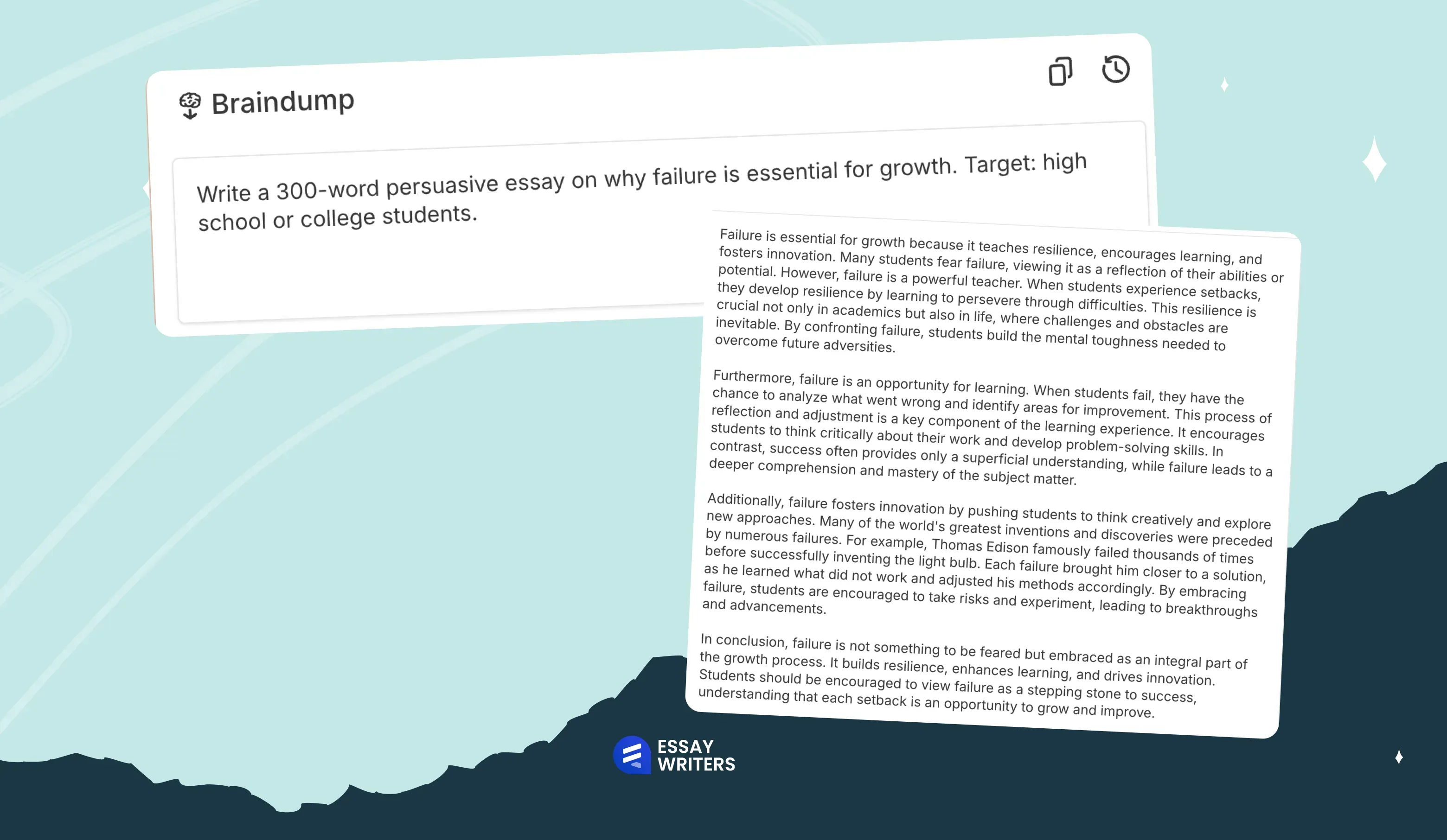
Failure is essential for growth because it teaches resilience, encourages learning, and fosters innovation. Many students fear failure, viewing it as a reflection of their abilities or potential. However, failure is a powerful teacher. When students experience setbacks, they develop resilience by learning to persevere through difficulties. This resilience is crucial not only in academics but also in life, where challenges and obstacles are inevitable. By confronting failure, students build the mental toughness needed to overcome future adversities.
Furthermore, failure is an opportunity for learning. When students fail, they have the chance to analyze what went wrong and identify areas for improvement. This process of reflection and adjustment is a key component of the learning experience. It encourages students to think critically about their work and develop problem-solving skills. In contrast, success often provides only a superficial understanding, while failure leads to a deeper comprehension and mastery of the subject matter.
Additionally, failure fosters innovation by pushing students to think creatively and explore new approaches. Many of the world's greatest inventions and discoveries were preceded by numerous failures. For example, Thomas Edison famously failed thousands of times before successfully inventing the light bulb. Each failure brought him closer to a solution, as he learned what did not work and adjusted his methods accordingly. By embracing failure, students are encouraged to take risks and experiment, leading to breakthroughs and advancements.
In conclusion, failure is not something to be feared but embraced as an integral part of the growth process. It builds resilience, enhances learning, and drives innovation. Students should be encouraged to view failure as a stepping stone to success, understanding that each setback is an opportunity to grow and improve.
Human Written
Can you imagine a world where there’s no such thing as failure? A place where we pursue a goal and the path we take is so smooth, so free of challenges, that the road is but a faint breath of wind? That world is a product of our imagination, a utopia. And, however tempting it might look at first glance, I do not think there is a single person who would choose to live in a world so unimaginably made-up that it transcends human comprehension. So, for better or worse, the road to success follows a rugged pathway accompanied by failures. This paper will showcase why failure is essential for growth.
Let’s take a moment and try to recall the beginning of our lives on this earth, mainly the process of learning to walk. Isn’t it a set of child’s failed attempts to stay on his feet? After falling time and time again, a human nature - deeply embedded in our very core - pushes the child to get up and try again. Ultimately, the child does not only stay on his feet, but he has found the ability within himself to walk on his own two feet. This is the perfect representation of the essential role of failure for growth. And most importantly, it is a universal experience for every one of us.
Failure is not synonymous to a mistake. It is a driving force that builds resilience; an illustration of Aristotle’s ‘unmoved mover’ - eternal, unchanging, yet an ultimate source of motion, better yet, motivation.
Human beings are destined to fail, but the instinct of self-preservation, ingrained into our being through evolution, drives us towards rising up, starting over, and reaching our final goal. This is the process of growing, and without failure, the growth is doomed to futility.
Side-by-Side Analysis
This table compares humans VS AI writing.
Clarity | Originality | Emotional Depth | Logic & Structure | Authentic Voice | Score | |
|---|---|---|---|---|---|---|
Human | 9/10 | 10/10 | 10/10 | 9/10 | 10/10 | 48/50 |
ChatGPT-4 | 9/10 | 6/10 | 4/10 | 9/10 | 5/10 | 33/50 |
Writesonic | 7/10 | 5/10 | 4/10 | 7/10 | 3/10 | 26/50 |
Anyword | 8/10 | 5/10 | 5/10 | 7/10 | 4/10 | 26/50 |
Rytr | 7/10 | 4/10 | 3/10 | 7/10 | 4/10 | 25/50 |
Sudowrite | 7/10 | 6/10 | 5/10 | 6/10 | 5/10 | 29/50 |
As you can see, the table clearly demonstrates the difference between an essay written by AI VS human.
In-Depth Evaluation
In this section, we will evaluate human and AI writing according to four main criteria and explain why human writing is better than AI:
Voice & Personality
When comparing AI vs human writing, voice, and personality are where the difference stands out the most. The human essay we tested had character, and a reference to Aristotle revealed curiosity about philosophy. You could tell there was someone who thinks and feels behind the words.
AI writing, in contrast, felt distant. The sentences were clean but lifeless, polished yet empty of individuality. It followed every rule and broke none, which made it sound like a manual rather than a mind. You couldn’t trust it with a topic that asks for honesty or vulnerability, because it never sounds like anyone at all.
Original Thought
When you read human writing, you can feel a mind at work. Real writers bring fresh angles, unseen connections, and intriguing questions. In our AI vs human writing experiment, the human essay didn’t stop at just explaining failure and growth and explored where those ideas come from and why they matter.
AI essays, on the other hand, repeated familiar patterns. Every version circled the same overused examples, like Edison’s countless lightbulb failures. According to a University of California study, human writers consistently create more layered narratives, while AI-generated texts remain formulaic and filled with clichés.
Coherence & Structure
Both AI and humans can organize an essay neatly, but the difference appears in how ideas are presented. In AI vs human writing, the human text flows like thought itself, with one idea shaping the next through natural rhythm and subtle connection. Transitions feel effortless because that’s how people think, shifting smoothly between reasoning and emotion.
AI essays, while technically structured, lack that organic motion. Sentences fit together, yet the joins are visible, almost mechanical. Each section follows a fixed formula, predictable from the start. A good essay should move like a mind unfolding in real time, something algorithms haven’t quite mastered yet.
Empathy & Persuasion
Empathy becomes the real test when comparing AI vs human writing. The human writer in our experiment built an argument that felt instantly relatable: learning to walk. Everyone has lived that story, which makes the point about failure and growth land on a deeply personal level.
AI can describe empathy, but it can’t feel it. That absence of emotion shows, especially when the goal is to move or motivate someone. Emotional depth can’t be replicated through prediction alone. A study by Edelman revealed that while 55% of tech executives recognize AI-generated text, only 45% of the public do, meaning that people still perceive the difference, even if they can’t always identify it.
Why Humans Still Win
We can give credit to AI for being excellent at summarizing, paraphrasing, and structuring. It’s fast and mostly reliable but lacks soul, perspective, and lived experience.
We tell stories, share personal anecdotes, and are honest with our feelings. We connect, empathize, and relate. The gap between AI and human writing may shrink, but it’s not closing on what matters most: intent, impact, and identity.
How can humans write better than AI? The answer is that AI can simulate meaning, but only humans can mean it.
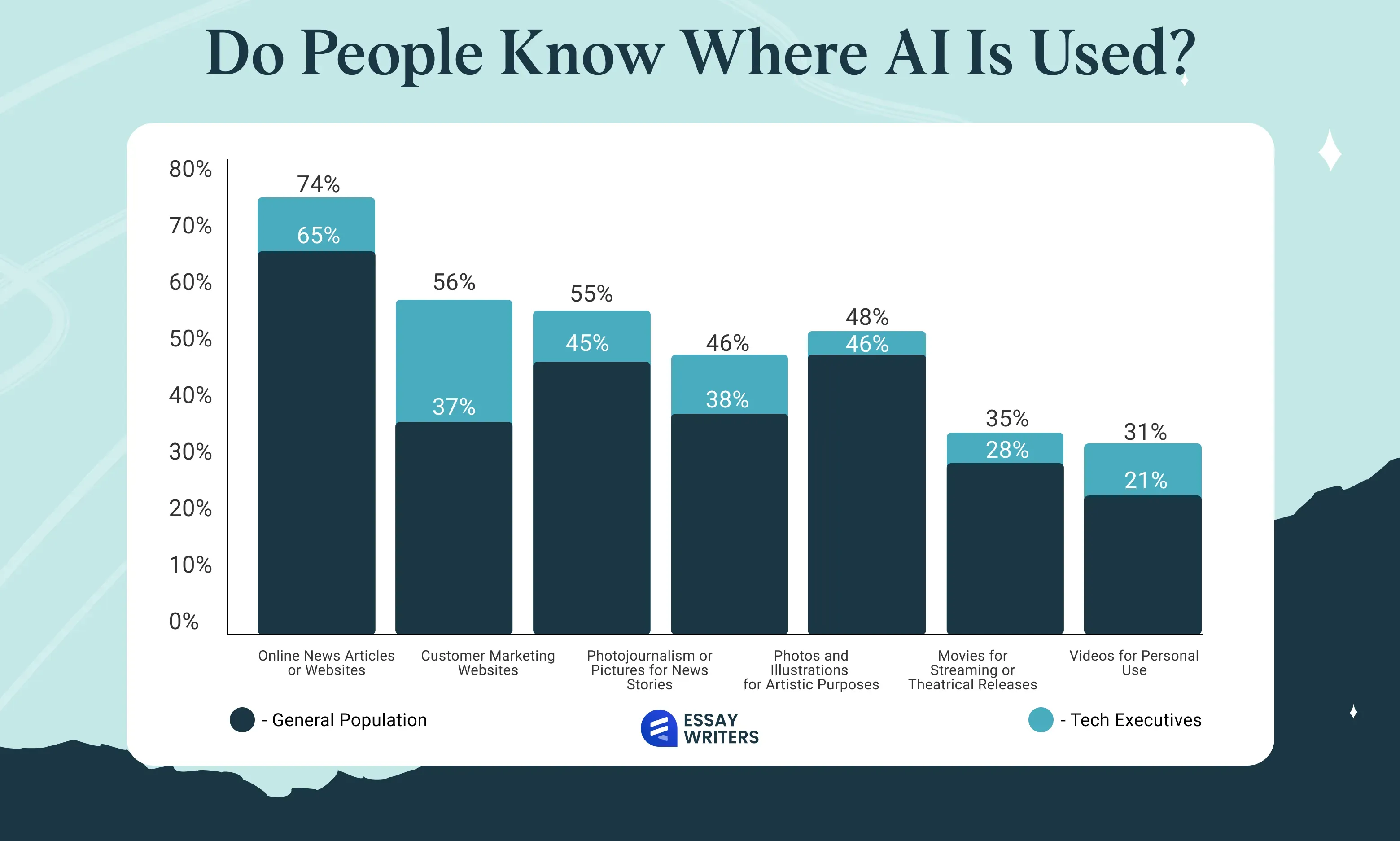
Cases Where Human Writing Is Essential
AI can help with straightforward tasks, but in most situations, human writing is absolutely essential. This is the list of cases that couldn’t be trusted to AI:
- College essays and admissions
- Emotional storytelling
- Personal statements
- Journalism
- Brand copy
- Argumentative/persuasive writing
- Academic research
A survey published by A. Guttmann in September 2024 shows that U.S. adults largely prefer human-driven media content. While 69% favor human-created news and photojournalism, AI is more accepted in movies (18%) and marketing (15%). Despite AI’s growth, human creativity and authenticity remain key in storytelling and artistic expression.
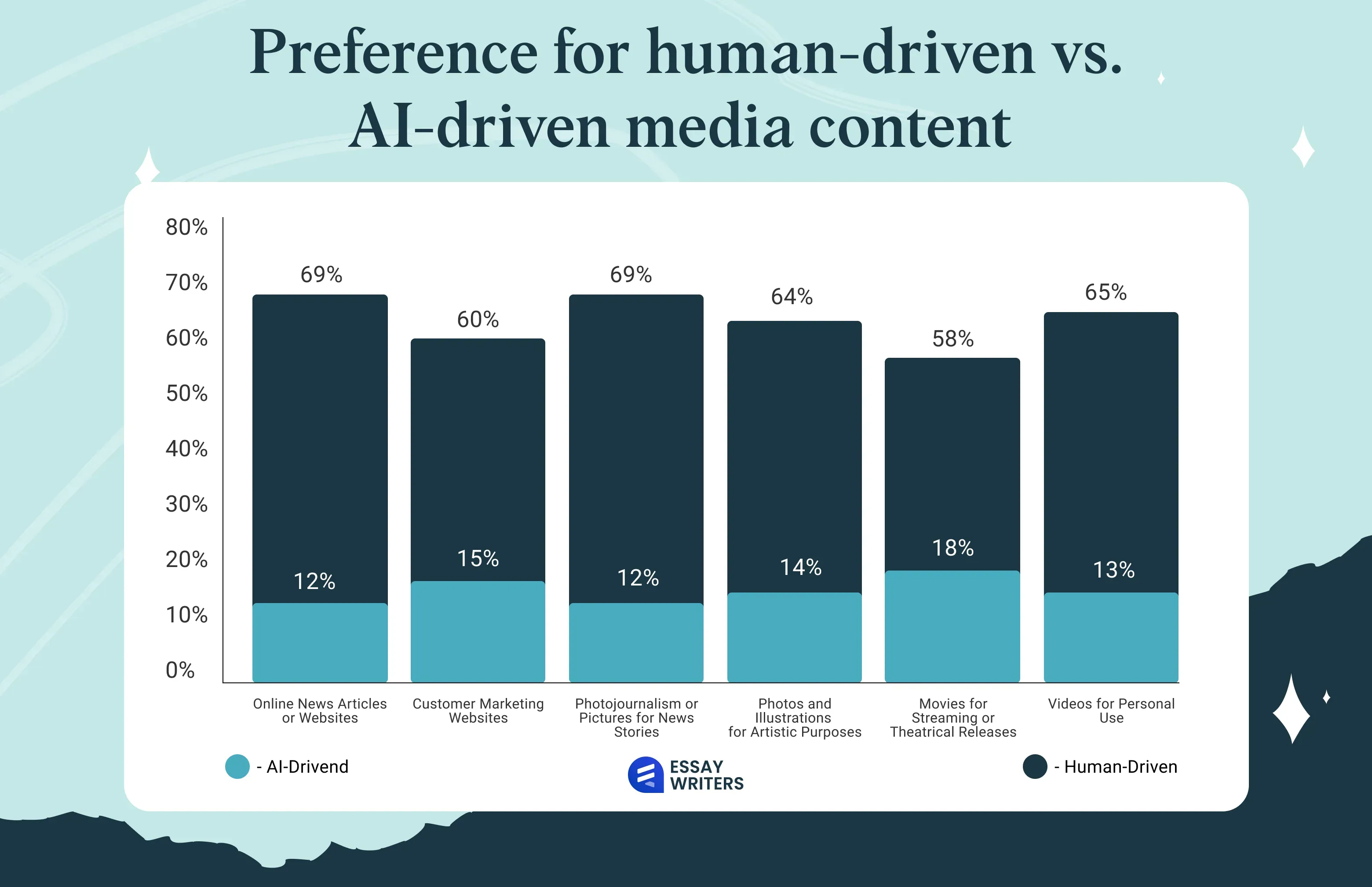
Final Thoughts: How Can Humans Write Better Than AI
The final verdict of our experiment is as follows: AI is a powerful tool for summarizing, organizing, and generating ideas but falls short when it comes to writing that truly connects with the reader. AI is fast. Human writing is fearless. This is why human writing is better than AI.
If you want your essay to resonate and make an impact, get help from real people. At EssayWriters, our expert essay writers rely solely on our knowledge and experiences and write papers that leave a lasting impression - just like in a well-structured SBAR Nursing Example, where clarity and purpose shape every word.
Sources
Amendola, Jodi. 2023. “Why Human Writers Are Superior to Generative AI.” Forbes, November 16, 2023. https://www.forbes.com/councils/forbesagencycouncil/2023/11/16/why-human-writers-are-superior-to-generative-ai/
Don’t worry. Study shows you’re likely a more creative writer than ChatGPT. For now. (2024, November 8). University of California. https://www.universityofcalifornia.edu/news/dont-worry-study-shows-youre-likely-more-creative-writer-chatgpt-now
Human and AI media content preference U.S. 2023| Statista. (2023). Statista. https://www.statista.com/statistics/1400715/human-and-ai-made-content-choice-us/


